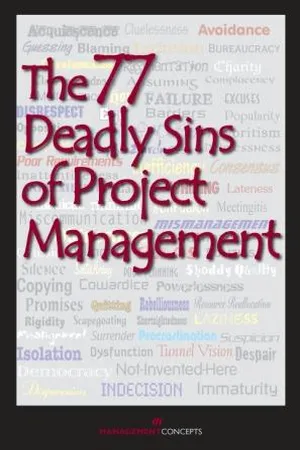
- 368 pages
- English
- ePUB (mobile friendly)
- Available on iOS & Android
The 77 Deadly Sins of Project Management
About this book
Combat the Deadly Sins of Project Management!
Project management is a tough business. Not only must project managers contend with schedules, budgets, and a host of stakeholder demands, but they must also deal with sometimes vexing human behaviors, such as whining, indecision, opposition, inflexibility, complacency, and tunnel vision, to name a few. Projects can be negatively impacted by common "sins" that hinder, stall, or throw the project off track.
In The 77 Deadly Sins of Project Management, the contributors focus on each "deadly sin" and probe its manifestations and consequences for projects. By sharing their personal experiences, as well as some historical events, the contributors spotlight the effects and costs — both financial and human — of failing to get a handle on these sins and reign them in. Through anecdotes and case studies, The 77 Deadly Sins of Project Management will help you better understand how to execute the myriad aspects of today's projects.
• Identify danger signs and solutions for each "sin"
• Learn proven methods for tackling project mishaps
• Gain practical and hands-on information from seasoned professionals
• Keep a variety of "sins" from derailing your project
BONUS!Each book comes with a "77 Deadly Sins of Project Management" poster!
Frequently asked questions
- Essential is ideal for learners and professionals who enjoy exploring a wide range of subjects. Access the Essential Library with 800,000+ trusted titles and best-sellers across business, personal growth, and the humanities. Includes unlimited reading time and Standard Read Aloud voice.
- Complete: Perfect for advanced learners and researchers needing full, unrestricted access. Unlock 1.4M+ books across hundreds of subjects, including academic and specialized titles. The Complete Plan also includes advanced features like Premium Read Aloud and Research Assistant.
Please note we cannot support devices running on iOS 13 and Android 7 or earlier. Learn more about using the app.
Information
1 Acquiescence
The Sin
A Case of Acquiescence
Danger Signs
Solutions
Tips for Addressing Acquiescence
- Ensure that all affected team members actively contribute to the discussion around team decisions.

- Facilitate an organized discussion, with each person getting an explicit turn to speak his or her mind, voicing at least one concern even with a decision they support.

- Capture and circulate the team’s agreement in writing to avoid any misunderstandings.

- Create an environment where team members are not afraid to speak their minds.

2 Assuming
The Sin
- Scoping assumptions. For example, we may assume that our project includes the requirement to produce a full set of documentation, that it needs to be provided in English only, and that we can supply it in electronic format.

- Planning assumptions. For example, we expect all named members of the project team to be available when we require them, to stay on the project for the full duration, and to have the skill set they need to perform their assigned tasks.

- Estimating assumptions. For example, we assume that the cost of a novel task can be derived by multiplying the number of people on the task and a standard daily rate by the average number of days that this task has taken on previous similar projects.

A Case of Assuming
Solutions
- List assumptions
- Test assumptions
- Identify risks.
Table of contents
- Cover
- Title Page
- Copyright
- Contents
- Preface
- Chapter 1 - Acquiescence
- Chapter 2 - Assuming
- Chapter 3 - Avoidance
- Chapter 4 - Barriers
- Chapter 5 - Blaming
- Chapter 6 - Blinders
- Chapter 7 - Bureaucracy
- Chapter 8 - Carelessness
- Chapter 9 - Chaos
- Chapter 10 - Charity
- Chapter 11 - Close-Mindedness
- Chapter 12 - Cluelessness
- Chapter 13 - Complacency
- Chapter 14 - Conflict
- Chapter 15 - Confusion
- Chapter 16 - Consensus
- Chapter 17 - Copying
- Chapter 18 - Cowardice
- Chapter 19 - Creep
- Chapter 20 - Democracy
- Chapter 21 - Despair
- Chapter 22 - Deviation
- Chapter 23 - Dispassion
- Chapter 24 - Disrespect
- Chapter 25 - Dysfunction
- Chapter 26 - Ego
- Chapter 27 - Excess
- Chapter 28 - Exclusion
- Chapter 29 - Excuses
- Chapter 30 - Failure
- Chapter 31 - Favoritism
- Chapter 32 - Fragmentation
- Chapter 33 - Gaming
- Chapter 34 - Guessing
- Chapter 35 - Haphazardness
- Chapter 36 - Helplessness
- Chapter 37 - Hope
- Chapter 38 - Immaturity
- Chapter 39 - Inattentiveness
- Chapter 40 - indecision
- Chapter 41 - inefficiency
- Chapter 42 - Inflexibility
- Chapter 43 - Isolation
- Chapter 44 - Lateness
- Chapter 45 - Laziness
- Chapter 46 - Magical Thinking
- Chapter 47 - Malfeasance
- Chapter 48 - Meetingitis
- Chapter 49 - Misalignment
- Chapter 50 - Miscommunication
- Chapter 51 - Mismanagement
- Chapter 52 - No Authority
- Chapter 53 - Not-Invented-Here
- Chapter 54 - Obtuseness
- Chapter 55 - Omission
- Chapter 56 - Opposition
- Chapter 57 - Politics
- Chapter 58 - Poor Planning
- Chapter 59 - Poor Requirements
- Chapter 60 - Popularity
- Chapter 61 - Powerlessness
- Chapter 62 - Prevarication
- Chapter 63 - Procrastination
- Chapter 64 - Promises
- Chapter 65 - Quitting
- Chapter 66 - Rebelliousness
- Chapter 67 - Resource Reallocation
- Chapter 68 - Rigidity
- Chapter 69 - Satisficing
- Chapter 70 - Scapegoating
- Chapter 71 - Shoddy Quality
- Chapter 72 - Shortsightedness
- Chapter 73 - Silence
- Chapter 74 - Surrender
- Chapter 75 - Suspicion
- Chapter 76 - Tunnel Vision
- Chapter 77 - Whining
- Assessment Tool: Which Sins Are Plaguing Your Project?
- Assessment Tool: What Are the Challenges on Your Project?
- About the Contributors
- Related Project Management Resources